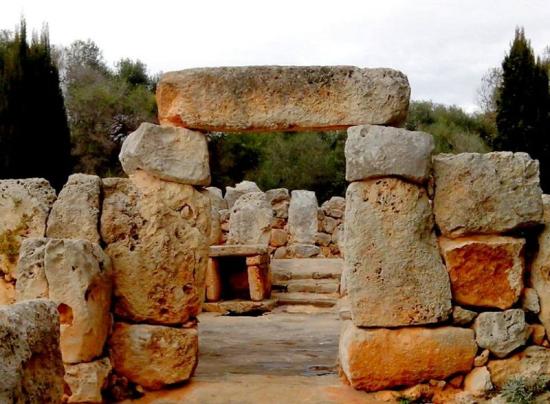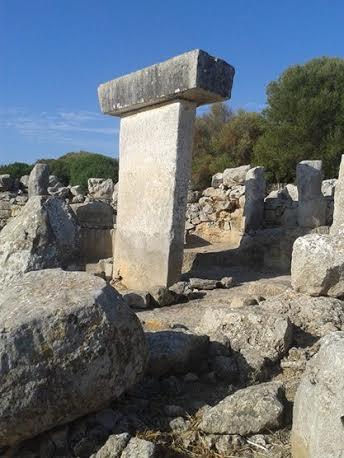Montserrat Anglada, Cristina Bravo, and Irene Riudavets
Source - http://popular-archaeology.com/issue/june-2013/article/unearthing-an-iron-age-sanctuary-in-the-mediterranean

Entrance to a cyclopean talayotic house, Menorca.
In the summer of 2015 a team of archaeologists will begin excavation of a cyclopean sanctuary located on the Mediterranean island of Menorca. This type of building is monumental and exclusive to this island, with no parallel around the world. Because of this, fieldwork at this building will offer the opportunity to both researchers and excavators to uncover a unique megalithic religious center, where they will obtain information about the ritual practices carried out there and the whole meaning of the building in relation to their users: the so-called Talayotic society.
A Recent Prehistoric Society to be Discovered…the Talayotic
The sanctuary under archaeological investigation is located at the site of Sa Cudia Cremada, a talayotic site (Bronze and Iron Age) which is located in the outskirts of the city of Mahón, the capital of the island. Fieldwork will be carried out by Sa Cudia Cremada Field School: Mediterranean Archaeology in Menorca, an organization that is calling for participants to attend courses which are scheduled for the summer of 2015 in August and September. (By joining the Field School team, participants will have the opportunity to dig in a megalithic religious center, learn proper excavation techniques, work at the laboratory and discover the archaeology that this small paradise, the island of Menorca, hides!) The team aims to carry out scientific research as well as reach out to the general public so that everybody can learn about the archaeology of Menorca (not only professionals in the field of Archaeology and academic circles, but also the general public interested in archaeology).
Menorca is the easternmost of the Balearic Islands (Spain), a beautiful Mediterranean island that attracts visitors for its stunning nature and its unique archaeology. In fact, it was declared a Reserve of the Biosphere by the UNESCO in 1993, and it is currently a candidate to become a UNESCO World Heritage site for its recent prehistoric archaeology…which is unique in the World.

Taula monument of the site of Torralba d'en Salort, Menorca
More than 1500 archaeological sites have been located on the island, which has a total area of 700 km2. This means that the density of archaeological remains is that of 2 sites per one square kilometer. The vast majority of these sites date back to the Bronze and Iron Age, from a period which is known as the Talayotic, in reference to the society, the “talaiotics”, who lived on the island from approximately the 2nd millennium BC up to the conquest of the Balearics by Rome in 123 BC.
The Talayotic society was confined to Menorca and its neighbor, Majorca, and was formed by a community of indigenous peoples from the two islands. They experienced an evolution in their social organization (from a relatively egalitarian society to a hierarchized one from the beginning of the first millennium BC), although many other aspects did not change over time, such as their cyclopean construction technique, their hand-made pottery production, an economy based on farming and stock-breeding and their complex funerary rituals and practices. The funerary evidence suggests they had strong religious beliefs and took very seriously the passing into the afterlife. However, many questions have been left unanswered, partly because they left no traces of a written and spoken language.
The excavation of a cyclopean sanctuary from this past society will shed light on the lives of an island society that developed unique cultural manifestations but, at the same time, acquired some traits from other Mediterranean peoples that reached Menorca and had cultural or commercial contacts with other societies, such as Punics, Greeks and Iberians. Those contacts intensified around 500-400 BC, especially with Punics who, by that time, had a vast territory of the western Mediterranean sea under their control, including the island of Ibiza, quite close to Menorca, the northern coast of Africa and the southeast of the Iberian peninsula, among other places.
In fact, Punics hired talayotic men in order to use them as mercenaries for their troops in the Sicilian wars, against Greeks, since they were very skillful in the use of the slingshot. Since all this started, in the middle of the 1st millennium BC, Balearic slingshot warriors fought for the Punics in many battles in many parts of the Mediterranean, including the Punic Wars against Rome, and became famous all around the ancient world for being skillful and fierce fighters. Many classical writers like Pliny, Strabo. Livy or Diodorus Siculus, praised the bravery of these warriors of the Balearic Islands, and described in detail aspects of their training, use of the slingshot, tastes and even how they were paid for their services. In fact, written sources state that these warriors refused payment with money—they preferred wine and women instead. Later on, the Balearic slingshot warriors were hired by Romans, who used them as light infantry in many battles, including the civil wars from the Late Republican period.
PART.2